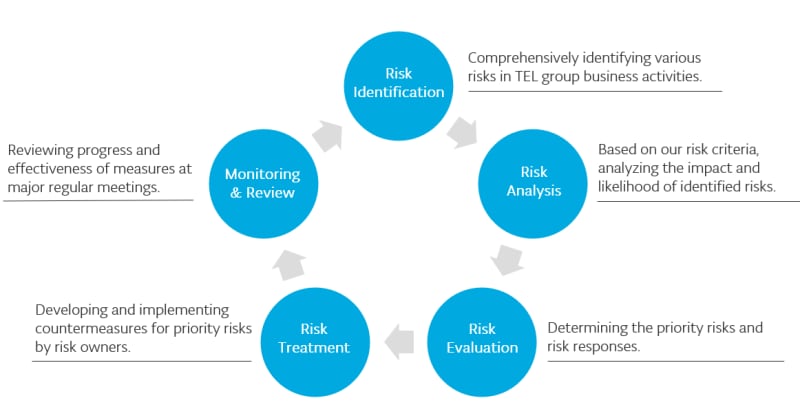| ⒈Market Fluctuations |
- A rapid contraction of the semiconductor market could lead to overproduction or an increase in dead inventory
- A sharp increase in demand could lead to an inability to supply customers with products in a timely manner, resulting in lost opportunities
|
- Periodically review market conditions and orders received at the Board of Directors and other important meetings, and appropriately adjust capital investments, personnel/inventory planning and other aspects of business
- Establish a dedicated division to work closely with a wide range of customers around the world and to quickly identify their needs and capital spending trends. Through these efforts and others, we strive to strengthen our sales framework and further improve our customer responsiveness
|
| 2.Research and Development |
- Delays in the launch of new products or the mismatch of such products with customer needs could lead to a decline in the competitiveness of products
|
- Establish the Corporate Innovation Division and build a Group-wide development framework that integrates innovative technology development with the technologies of each development division
- Provide highly competitive next-generation products ahead of competitors by collaborating with research institutions and sharing a technology roadmap spanning multiple generations with leading-edge customers
|
| 3.Geopolitics |
- Geopolitical tensions and regional conflicts that influence international order and global macroeconomic conditions can affect the national security, diplomatic, industrial or environmental policies of countries and regions. This could in turn lead to supply chain disruptions or deterioration of the macroeconomic environment, restricting the Company’s ability to operate business
|
- Carefully monitor the international situation as well as the diplomatic and security measures and industrial policy trends in each country and region
- Analyze the implications on our business of regulations concerning product exports and imports and technological development and changes in the macroeconomic environment while actively engaging in dialogues with the policy-making authorities, industry groups and experts in various fields, and consider countermeasures in advance
|
| 4.Procurement, Production and Supply |
- Increased demand that exceeds suppliers' supply capacities, changes in laws and regulations, a shrinking working population or other factors, and strains on domestic or international logistics networks, as well as interruption of the Company's production due to natural disasters, could lead to delays in the supply of products to customers
|
- Increased demand that exceeds suppliers' supply capacities, changes in laws and regulations, a shrinking working population or other factors, and strains on domestic or international logistics networks, as well as interruption of the Company's production due to natural disasters, could lead to delays in the supply of products to customers
- Share forecasts based on demand projections for semiconductors with suppliers and build a system for the stable supply of products
|
| 5.Safety |
- Safety problems with the Company's products or serious accidents resulting in workplace injuries could lead to damage to customers, liability for damages and a decline in public trust and confidence in the Company's safety initiatives
|
- Based on the “Safety First” approach, we implement thorough safety design at the product development phase with risk reduction in mind
- By conducting risk assessments such as frontline workers' hazard prediction meetings, we implement company-wide efforts such as identifying potential risks and implementing preventative or mitigation measures, promoting safety through in-house competency qualification and safety training programs that are designed according to job requirements for employees and subcontractor employees, and developing an incident reporting system
|
| 6.Quality |
- The occurrence of a product defect could lead to liability for damages, costs for countermeasures and a decline in the Group’s brand and credibility
|
- Promote continuous education on quality for employees and subcontractor employees, and suppliers to work toward establishing a quality assurance system and the highest standard of service system
- Resolve technical issues from the product development and design stage
- Thoroughly investigate the cause of any defects and implement measures to prevent the same or similar defects from occurring
- Monitor the quality status of suppliers, conduct audits and provide support for improvement
|
| 7.Environmental Issues |
- The inability to respond appropriately to each country/region's climate change policies, environmental laws and regulations, and customer needs could lead to additional related costs such as for developing products or changing facilities at locations, as well as reduced product competitiveness, diminished public confidence in the Company, penalties, and compensation for damages
|
- To achieve industry leading environmental goals that include the net zero target, implement measures such as reducing greenhouse emissions from the use of our products, increase the rate of renewable energy usage at plants and offices, reduce overall power consumption, review packaging materials, and promote a modal shift
- Provide technologies, etc., that contribute to higher performance and energy efficiency of semiconductor devices through implementation of our E-COMPASS initiative
|
| 8.Laws and Regulations |
- Violations of the laws and regulations of the countries and regions where the Company operates could lead to suspension or restriction of operations, including product manufacturing activities, additional response costs, diminished public confidence in the Company, and penalties or compensation for damages
|
- Monitor compliance activities at key sites in and outside Japan under the direction of the Chief Compliance Officer
- Regularly conduct compliance self-assessments using globally established evaluation indicators defined by third parties and address the issues identified
- Comprehensively organize the standards and specifications that our products must comply with and carry out product compliance activities to support proper operations
|
| 9.Intellectual Property Rights |
- The inability to obtain exclusive rights to proprietary technologies could lead to reduced product competitiveness
- Infringement of the intellectual property rights of third parties could lead to restrictions on the production and sale of products as well as liability for damages
|
- Advance the intellectual property strategy, business strategy and R&D strategy in an integrated manner to build an appropriate intellectual property portfolio
- Reduce the risk of infringement of other companies' patents by continuously monitoring other companies' patents and establishing a system to take appropriate measures in cooperation with the business and R&D departments
|
| 10.Information Security |
- Cyberattacks, internal fraud and other incidents against the Company or suppliers that cause data leakage could result in a loss of our competitiveness due to damages to our technological superiority, interruptions of our operations, diminished public confidence in us and damage claims
|
- We strive to properly manage and protect our information assets through establishing a global security policy, educating and training employees to increase awareness, while implementing cybersecurity solutions, security monitoring, and safeguards against internal fraud and other technical and operational measures
- We have established an Information Security Committee to strengthen our group-wide security posture and are working to further enhance the effectiveness of our information security measures, including through internal audits and assessments by external agencies
|
| 11.Human Resources |
- The inability to recruit and retain necessary human resources on an ongoing basis or the inability to create an environment where people with diverse values and expertise can perform well active role could lead to diminished product development capability or customer support quality, thereby impacting competitivenesss
|
- Make continuous improvements to work environments and promote diverse work styles as well as health and productivity management (e.g., sharing our visions by management, establishing training plans for human resource who will lead the future, visualizing career paths for employees and offering attractive remuneration and benefits)
- Fostering semiconductor talent through collaborative efforts between industry, government, and academia as well as strengthening our partnerships with academic institutions globally
|
12.Other Risks Such as Infectious Diseases and Natural Disasters
|
- The occurrence of large-scale infectious diseases, natural disasters, terrorism, etc., on a global or regional scale may threaten the safety of officers, employees, and their families, and restrictions on movement between countries may affect business activities
|
- Based on our Business Continuity Plan (BCP), we have introduced a safety confirmation system to check the well-being of officers, employees, and their families and have conducted disaster prevention drills to raise disaster awareness
|
| 13.Finance |
- Sudden foreign exchange fluctuations due to factors such as international conditions or interest rate changes may affect business performance
- Additional tax burdens may arise if differing interpretations occur with the relevant authorities regarding the tax laws of individual countries and regions
|
- The finance executive officer and Finance Division have established a global risk management system in collaboration with the Corporate Strategy Division and finance leaders at each Group company
- As a rule, our products are transacted in yen, but for a portion of foreign currency-denominated sales, we implement risk hedging through foreign exchange forward contracts
|
| 14.M&A |
- Insufficient due diligence of target companies or businesses for acquisition, inadequate post-merger integration (PMI) of acquired companies or businesses resulting in failure to achieve intended results, or potential targets being acquired first by competitors may impact competitiveness
|
- Led by the Corporate Strategy Division, policies are regularly reviewed at meetings including the CEO, and investment decisions are made taking into account synergies and risks with our Group
- After acquisitions or investments, plans are formulated and implemented based on strategy and risk
|
| 15.IT&Operation |
- Major disruptions in enterprise systems may have a serious impact on business
- Delays in digitalization or business process reforms may make it difficult to execute effective and efficient operations that align with growing businesses or new regulations
|
- Formulate a Business Continuity Plan (BCP) for IT systems and utilize a Disaster Recovery (DR) data center to conduct operational training using backup systems
- Launch a business reform DX promotion project to review company-wide business processes and systems from various perspectives, including productivity improvement, regulatory compliance, and strengthening, to manage risk
|
| 16.Business Location |
- Insufficient consideration of location strategy for the global increase in new businesses, delays in investment plans, or inadequate personnel allocation may make it difficult to effectively and efficiently expand new sites or strengthen and control existing sites
|
- Formulate and execute location strategies aligned with our business strategies
- Group companies overseeing each country and region promote smooth operations and risk management tailored to the characteristics of each business and each country or region
|

